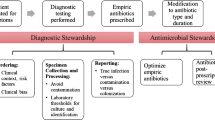Abstract
Background
The pediatric definition of bacterial urinary tract infection (UTI) is >50,000 colony forming units (CFU) of a single organism on catheterized culture or 10,000–50,000 CFU with pyuria on urinalysis.
Local problem
The diagnosis of UTI in our NICU is clinician-dependent and not based on the accepted pediatric definition.
Methods
A retrospective review of positive urine cultures between 2015 and 2017 was performed.
Intervention
A treatment guideline for positive urine cultures was adopted and PDSA methodology utilized for incremental improvements.
Results
For 909 pre-intervention neonates, 26 of 38 positive urine cultures were treated for UTI but only 23% (6/26) met the pediatric definition. For 644 post-guideline neonates, only 7 of 25 positive urine cultures were treated and 86% met guideline criteria with no increase in urosepsis.
Conclusions
A guideline to treat positive urine cultures resulted in a decreased rate of UTI diagnosis and thus prevented unnecessary antibiotic exposure.




Similar content being viewed by others
References
Bauer S, Eliakim A, Pomeranz A, Regev R, Litmanovits I, Arnon S, et al. Urinary tract infection in very low birth weight preterm infants. Pediatr Infect Dis J. 2003;22:426–30. https://doi.org/10.1097/01.inf.0000065690.64686.c9
Sastre JBL, Aparicio AR, Cotallo GDC, Colomer BF, Hernández MC. Urinary tract infection in the newborn: clinical and radio imaging studies. Pediatr Nephrol Berl Ger. 2007;22:1735–41. https://doi.org/10.1007/s00467-007-0556-5. Grupo de Hospitales Castrillo.
Zorc JJ, Kiddoo DA, Shaw KN. Diagnosis and Management of Pediatric Urinary Tract Infections. Clin Microbiol Rev. 2005;18:417–22. https://doi.org/10.1128/CMR.18.2.417-422.2005
Drumm CM, Siddiqui JN, Desale S, Ramasethu J. Urinary tract infection is common in VLBW infants. J Perinatol. 2019;39:80–85. https://doi.org/10.1038/s41372-018-0226-4
Urinary Tract Infection. http://www.cdc.gov/nhsn/pdfs/pscManual/7pscCAUTIcurrent.pdf. Published online 2021:18.
Arshad M, Seed PC. Urinary tract infections in the infant. Clin Perinatol. 2015;42:17–vii. https://doi.org/10.1016/j.clp.2014.10.003
Austin BJ, Bollard C, Gunn TR. Is urethral catheterization a successful alternative to suprapubic aspiration in neonates? J Paediatr Child Health. 1999;35:34–36. https://doi.org/10.1046/j.1440-1754.1999.00305.x
Korbel L, Howell M, Spencer JD. The clinical diagnosis and management of urinary tract infections in children and adolescents. Paediatr Int Child Health. 2017;37:273–9. https://doi.org/10.1080/20469047.2017.1382046
Ww J, Rd P. Utility of dipstick urinalysis as a guide to management of adults with suspected infection or hematuria. South Med J. 1998;91:266–9. https://doi.org/10.1097/00007611-199803000-00010
Mori R, Yonemoto N, Fitzgerald A, Tullus K, Verrier-Jones K, Lakhanpaul M. Diagnostic performance of urine dipstick testing in children with suspected UTI: a systematic review of relationship with age and comparison with microscopy. Acta Paediatr Oslo Nor 1992. 2010;99:581–4. https://doi.org/10.1111/j.1651-2227.2009.01644.x
Shaikh N, Shope TR, Hoberman A, Vigliotti A, Kurs-Lasky M, Martin JM. Association Between Uropathogen and Pyuria. PEDIATRICS. 2016;138:e20160087. https://doi.org/10.1542/peds.2016-0087
Samayam P, Ravi Chander B. Study of urinary tract infection and bacteriuria in neonatal sepsis. Indian J Pediatr. 2012;79:1033–6. https://doi.org/10.1007/s12098-012-0727-7
Flannery DD, Brandsma E, Saslow J, Mackley AB, Paul DA, Aghai ZH. Do Infants in the Neonatal Intensive Care Unit Diagnosed with Urinary Tract Infection Need a Routine Voiding Cystourethrogram? J Matern-Fetal Neonatal Med J Eur Assoc Perinat Med Fed Asia Ocean Perinat Soc Int Soc Perinat Obstet. 2019;32:1749–54. https://doi.org/10.1080/14767058.2017.1416352
Eliakim A, Dolfin T, Korzets Z, Wolach B, Pomeranz A. Urinary tract infection in premature infants: the role of imaging studies and prophylactic therapy. J Perinatol J Calif Perinat Assoc. 1997;17:305–8.
Lin DS, Huang SH, Lin CC, Tung YC, Huang TT, Chiu NC, et al. Urinary tract infection in febrile infants younger than eight weeks of Age. Pediatrics 2000;105:E20.
Cotten CM. Adverse consequences of neonatal antibiotic exposure. Curr Opin Pediatr. 2016;28:141–9. https://doi.org/10.1097/MOP.0000000000000338
Esaiassen E, Fjalstad JW, Juvet LK, van den Anker JN, Klingenberg C. Antibiotic exposure in neonates and early adverse outcomes: a systematic review and meta-analysis. J Antimicrob Chemother. 2017;72:1858–70. https://doi.org/10.1093/jac/dkx088
Marsh MC, Watson JR, Holton C, Hill N, Saldivar L, Janse S, et al. Relationship between clinical factors and duration of IV antibiotic treatment in neonatal UTI. Hosp Pediatr. 2020;10:743–9. https://doi.org/10.1542/hpeds.2019-0325
Walawender L, Hains DS, Schwaderer AL. Diagnosis and imaging of neonatal UTIs. Pediatr Neonatol. 2020;61:195–200. https://doi.org/10.1016/j.pedneo.2019.10.003
Acknowledgements
Dr. Ellen Wald, Dr. Ruthie Su, Dr. Allison Redpath, Dr. Michael Semanik, Dr. Pamela Kling and Dr. Ryan McAdams for their early contributions to the development of the guideline.
Author information
Authors and Affiliations
Corresponding author
Ethics declarations
Conflict of interest
The authors declare no competing interests.
Additional information
Publisher’s note Springer Nature remains neutral with regard to jurisdictional claims in published maps and institutional affiliations.
Rights and permissions
About this article
Cite this article
Gorski, D.P., Bauer, A.S., Menda, N.S. et al. Treatment of positive urine cultures in the neonatal intensive care unit: a guideline to reduce antibiotic utilization. J Perinatol 41, 1474–1479 (2021). https://doi.org/10.1038/s41372-021-01079-6
Received:
Revised:
Accepted:
Published:
Issue Date:
DOI: https://doi.org/10.1038/s41372-021-01079-6
- Springer Nature America, Inc.
This article is cited by
-
Urinary tract infections in very premature neonates: the definition dilemma
Journal of Perinatology (2024)




